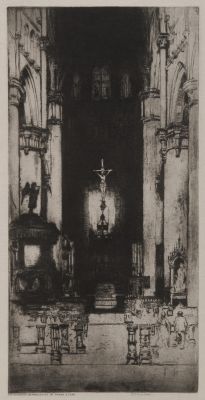
Title
Loch AlineArtist
Cameron, D.Y. (Scottish, 1865-1945)Date
1926Process
EngravingAtelier
D.Y. CameronImage Size
20 x 30 cmSheet Size
30.5 x 43 cm
Cameron was interested in portraying the grandeur and beauty of the Scottish Highlands, which he achieved through design rather than picturesque detail. He concentrated on the structure, tone and balance of the landscape. After giving up etching in 1917, Cameron took it up again in 1923. In this print Cameron shows the outline of Loch Aline but he has eliminated everything trivial to present a view of austere beauty that concentrates on the spirit of place.
D.Y. Cameron was a successful painter and a very influential etcher. He studied at the Glasgow School of Art before joining life classes at the Royal Scottish Academy. His work was acclaimed in Edinburgh, London, Berlin and Munich. During the First World War, Cameron was appointed official war artist to the Canadian government and in 1933 was made the King’s Painter in Scotland. Cameron was highly sought after by collectors until the Great Crash of 1929 brought a collapse in prices for prints in general. Despite his excellence as a printmaker, his work still remains underrated both in art historical and market terms.
Strong tonal contrasts characterize his prints and his stark and dramatic paintings, which are mainly landscapes and cityscapes. His prints often feature areas of great darkness, offset by highlights. Cameron’s etchings are notable for their use of drypoint, a skill that he had mastered over his years of production. This is particularly evident in his studies of church interiors and Scottish landscapes, such as Loch Aline.
Loch Aline is a small saltwater loch, located in Morvern, Lochaber, in Scotland, which Cameron depicted several times. In another better known etching/drypoint, he features three fine foreground trees, but this print is emptier, emphasising the desolate grandeur of the Scottish landscape. The sky and the loch mirror each other in shape and tone. They are broken up by the dark foliage of the hills surrounding the loch, their reflection slightly encroaching onto the surface. Ripples at the edge of the loch create movement in the otherwise still landscape. The vast expanse of sky throws into relief Cameron’s mastery of minimalist landscape composition and acute awareness of positive and negative space.
Reproduced / Exhibited
Hood Museum of Art, Dartmouth PR.954.20.109




